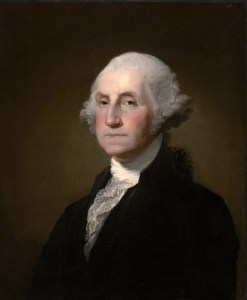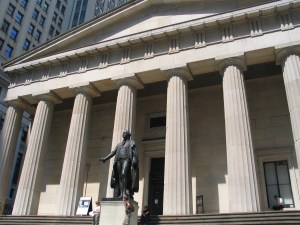
Celebrate the birthday of our nation’s first president on Feb. 22 or any day by visiting one or more of the places in NYC where George Washington was inaugurated, ate and drank, slept and prayed, and made famous in other ways.
That would include, of course, commanding the Continental Army to victory in the Revolutionary War, which also ended here in NYC in 1783, with a triumphal march by the soldiers along the city’s wide, main north-south street known as the Broad Way.
Some history books tell us the Continental Army soldiers stopped at 13 taverns to drink toasts to each of the 13 Colonies and celebrate the new country.
Today, of course, that street is Broadway, and it is still the site of famous parades, from ticker tape parades for American heroes, including returning World War II soldiers, moon-walking astronauts, popular US presidents, NYC teams which win the Super Bowl, and women’s soccer teams which win the world championships. And visiting presidents, too, including John F. Kennedy and First Lady Jacqueline Kennedy.
NYC Presidential History
There is just so much history in New York City, much of it connected with US presidents.
New York City was the first US capital, for nearly two years, before it moved to Philadelphia and then to Washington, D.C, close to Washington’s beloved home in Mount Vernon, Virginia.
Two US presidents were born in New York City -
President Theodore Roosevelt was born and raised in Manhattan and Donald J. Trump was born and grew up in Queens.
An ardent environmentalist and amateur archeologist, Roosevelt was one of the founders of the American Museum of Natural History, and also served as NYC Police Commissioner.
President Ulysses S. Grant is buried here, alongside his wife, in what’s popularly known as Grant’s Tomb.
The Grants retired to NYC after he left the White House.
But let’s focus on the first US President, George Washington.
Since New York City was pretty small in those days, you can visit most, if not all of George Washington’s New York in one long day.

Federal Hall National Monument
George Washington took the Oath of Office here in 1789, and his larger-than-life statue dominates the building entrance.
The land was donated by a Dutch merchant, first to become the first City Hall for what was then called New Amsterdam and sometimes New Netherland.
After the city was taken over by the British and renamed for the Duke of York, it became an important spot for Patriots to plan the revolution.
The 1765 Stamp Act Congress was held here, to protest “taxation without representation”, the slogan that helped build popular support for the war of independence, and the building served as the first US Capitol.
The original building was demolished in 1812, after the US capital moved from NYC to Philadelphia, and then to Washington, DC. The current building dates from 1849.
In addition to soaring columns outside, 16 massive marble Corinthian columns inside support an equally impressive rotunda, and there are excellent FREE historical exhibits.
- National Parks Rangers also lead FREE guided tours.
- 26 Wall St., open year-round, Mon.-Fri., 8am-5pm except Federal holidays.
Fraunces Tavern
The family of Etienne de Lancey lived here (Delancey Street is named for him) when Samuel Fraunces took over the place in 1763 and turned it into a tavern downstairs, with rooms to rent upstairs.
Yes, George Washington slept here. This was his last residence as General before becoming President.
In 1783, he famously said goodbye to his officers in the Long Room upstairs (pictured here) after taking the oath of office a few blocks away.
Downstairs continues to be a restaurant and bar, where you can eat traditional Colonial foods such as oysters and steak and drink traditional Colonial ciders and other grog, as well as more modern menu and bar items.
Upstairs, there’s a permanent collection of art, decorative arts and other artifacts from Colonial New York City.
- 54 Pearl St., Museum open year-round, Mon.-Sat., noon-5pm, except major holidays.
- There are FREE guided tours on Fridays at 2pm, and weekends at 1pm and 2pm
St. Paul’s Church and Churchyard
George Washington prayed here regularly, including after his inaugural a few blocks away. His pew is marked and roped off.
This is Manhattan’s only remaining pre-Revolutionary War church, dating from 1764. But these days, the church is more famous for surviving unscathed from that awful day in 2011 when the World Trade Center, a few blocks away was attacked and destroyed.
The church became a refuge for First Responders, who often slept on church pews, and were served meals by an army of volunteers.
There’s a display of badges, helmets and other memorabilia left by the police, fire and other service groups from around the world who came to help.
- Broadway at Fulton St.,
Trinity Church and Churchyard
The cemetery has graves dating from 1680. One of them is Washington’s brilliant right-hand advisor and associate, Alexander Hamilton, who founded the US banking system and served as Washington’s Secretary of the Treasury. His wife Eliza also is buried here, as is their eldest son, Philip.
Today, Hamilton’s grave is a popular tourist spot for fans of the Broadway musical.
Be sure to take the time to look towards the new World Trade Center, looking west, visible through the gravestones
Also visit the grave of another Revolutionary Era hero, John Peter Zenger, whose passion for freedom of the press is one of the basics of the democracy that is the United States of America. He’s buried near another newspaper publisher, Alexander Hamilton, who founded what is now the New York Post, the oldest continuously-published newspaper in the USA.
- Broadway and Wall St.
SEE ALSO
Where to see Hamilton in NYC, including his home
Stone Street
Reputed to be NYC’s first paved street, still paved with the original cobblestones that were used as ballast for ships coming to New York harbor before the Revolutionary War.
We don’t know for sure, but Washington may have imbibed at one of the 200+ taverns in NYC at the time. We do know he enjoyed hard cider and hard liquor, and distilled both at Mount Vernon.
Stone Street is lined with historic buildings from the 1800s, whose ground floors house old-fashioned taverns and pubs and new-fashioned boutiques.
In warm weather, this becomes a pedestrian-only street, and a lovely place to linger in warm weather when the cobblestones are covered with picnic tables. In any season, this is a great place to finish your day with George Washington.
- Stone Street is between Hanover Square and Coenties Slip in the Financial District
Additional places to find George Washington’s New York:
![NYC on the Cheap editor Evleyn Kanter]() New York Historical Society
New York Historical Society
Collection include the iconic portrait of General Washington by artist John Trumbull.
A new exhibit, Meet the Presidents, includes a full-size recreation of the Oval Office. NYC on the Cheap Executive Editor had the chance to sit behind the desk when the exhibit opened in Spring 2020
The exhibit also features a treasure trove of photos and paintings about all our presidents.
Federal Reserve Bank
Founded by Washington’s Secretary of the Treasaury Alexander Hamilton, for its billions of dollars in gold bullion, buried beneath the street.
 African Burial Ground National Monument
African Burial Ground National Monument
Graves dating from the 1600s, with the remains of more than 400 souls, were discovered in the 1990s during the excavation for a skyscraper.
Also read this article by my friend and fellow history buff Rich Grant with additional details about George Washington’s New York City.
Gilbert Stuart portrait of George Washington courtesy Wikipedia
Photo of JFK ticker tape parade courtesy NY Daily News
Stone Street photo courtesy Goldman Properties


What do you think about this? We welcome your comments.